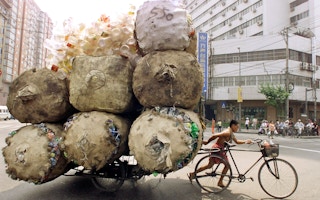China is playing a significant role in reducing the world’s carbon footprint since it became the biggest importer of recycled materials, used extensively in the country’s rapid infrastructure construction.
Also, improvements in China’s recycling industry regulations have helped to improve the standards of recycling globally.
“China’s growing economy has created great demand for scrap materials, and the use of scrap instead of primary materials reduces carbon emissions. Although China’s economic growth has slowed, it is still playing an important role,” says Alexandre Delacoux, director-general of the Brussels-headquartered Bureau of International Recycling.
With members from more than 70 countries, the bureau works to encourage best industrial practices in recycling so that the environmental impact of economic development is kept to a minimum.
According to 2008 research conducted by the bureau, the total estimated savings in carbon dioxide emissions obtained through recycling globally is approximately 500 million tonnes of carbon dioxide. Common recyclable materials include metals, paper and plastics.
“
China’s growing economy has created great demand for scrap materials, and the use of scrap instead of primary materials reduces carbon emissions. Although China’s economic growth has slowed, it is still playing an important role.
Alexandre Delacoux, director-general, Bureau of International Recycling
As China grows, much of its construction work is done using a lot of scrap metals no longer needed in other countries. Such material comes at a cheaper cost than new material, and it helps to reduce global carbon emissions.
For example, using recycled paper can save about 75 per cent of the energy needed to make new paper from virgin fiber. It can also reduce 35 per cent of the water pollution and 74 per cent of the air pollution caused in making new paper. Meanwhile, using ferrous scrap metals can save carbon dioxide emissions by 58 per cent compared with primary ore, according to the bureau.
The recycling organisation has more than 30 members from China, from cities such as Beijing, Hong Kong and Shanghai.
Delacoux says one significant change his team has witnessed in recent years is the improvement in the quality of China’s recycling practices, a result of the joint efforts of the Chinese government and companies.
One key policy that has changed China’s recycling industry is China’s Green Fence policy. Started in February 2013, it was designed to prevent the imports of solid waste-contaminated shipments.
The Green Fence policy has set a limit of 1.5 per cent of allowable contaminant in each bale in an effort to keep trash out of China. Previously, some Western companies would illegally send non-recyclable waste materials to China, hiding it by labeling it as recyclable materials.
Headed by Wang Jiwei, vice-president and secretary-general of the China Nonferrous Metals Industry Association Recycling Metal Branch, the initiative conducts random inspections of all forms of “imported waste”, meaning metals, plastic, textiles, rubber and recovered paper materials.
“The policy marked the beginning of Chinese authorities making sure whatever recycling material enters China is of good quality. Those companies that weren’t offering the right quality of recycling materials had to adjust their processing method to achieve the right quality,” Delacoux says.
When the program first started, it hit the Chinese recycling industry very hard, but two years down the line, many firms have adjusted their practices and now the overall quality of materials has improved.
“Due to the Green Fence program, the imported recycling materials are of much better quality. I think the Chinese recycling industry’s catching-up phase has passed, and China’s recycling industry standards are in line with the rest of the world,” he says.
As recycling costs in developed countries continue to grow, increasingly the world’s recycling industry is shifting to China. The United Kingdom’s exports of waste paper increased from 400,000 tonnes in 1998 to around 4.7 million tonnes in 2007, and exports of waste plastics increased from less than 40,000 tonnes to more than 500,000 in the same period.
More than half of the waste paper and more than 80 per cent of the plastic collected by the UK authorities, supermarkets and businesses for recycling are being sent to China, according to a report by WRAP, a private group based in the UK that works with government, companies and individuals on waste reduction.
Much of the waste sent to China is sorted in the UK first in accordance with export regulations. Under current international shipping laws, countries of the Organization for Economic Cooperation and Development can export waste to non-OECD countries only for recycling, not disposal.
As mixed waste falls into the “disposal” category, it cannot be exported to countries outside the bloc, as opposed to scrap metals that can be recycled into manufacturing products in countries like China.
China’s large waste and recycling market has created great opportunities for Western businesses. Some Western recycling companies are also sharing their innovative importing processes with China, and one of them is the German waste management and recycling company Alba, which started exporting recycled materials to China 20 years ago, including scrap metals, paper and plastic.










